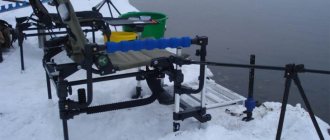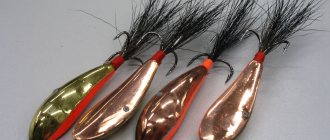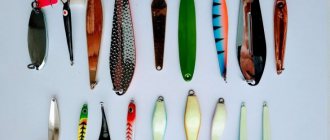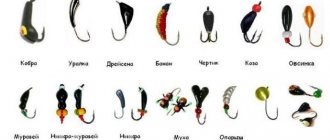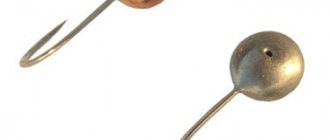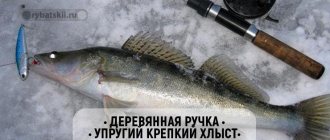Devils for perch
Devils for catching perch are reelless jigs, relatively large, spindle-shaped with a triple hook. The main critical feature of such a bait is strict centering relative to the vertical. Devils work and attract fish with a clearly defined vertical play without horizontal deviations. The main method of wiring is intermittent dotted rises and falls in various variations, similar to the movement of an amphipod crustacean in water. Striped loves low-amplitude, high-frequency play and dribbling. In the wilderness, the pace of the game slows down, but the basic law of mothlessness - monotony and the absence of failures - is still followed.
Catching perch in winter with a devil is possible using any size and shape of such jigs. But for targeted hunting for striped fish, it is better to use short, “bellied” baits. Perch reacts better to them. If during periods of activity you can tempt a predator to use any form of bait, including elongated “bream” baits, then in the middle of nowhere short and plump decoys work well. An article about catching perch with a reelless reel.
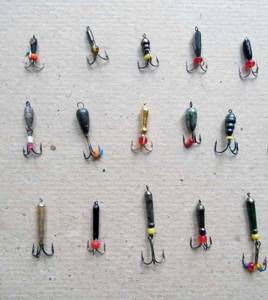
Crucian carp from ice to feeder equipment. December 2021
New video about fishing with a feeder from the bottom. In Kazakhstan, ice 20cm thick formed already at the end of November. And fishing on the first ice can be very successful. And so it happened.
Moreover, not only roach, but also crucian carp were caught from the ice using a feeder. The author uses a 20g feeder with a branch and a 20cm leash. Inert, heavy black bait "Bream-Roach". Bait bloodworms and worms. A short feeder made from a spinning rod handle and a feeder tip.
When lowering the feeder equipment into the hole, first the feeder is lowered, followed by a hook with bait. We had to look for fish by drilling a couple of dozen holes. The catch included excellent winter crucian carp and roach.
Catching crucian carp with a feeder from ice. End of 2021.
Search and catching tactics
Winter fishing for perch with devils is carried out according to all the canons of ice hunting for striped predators, observing the features of baitless fishing. In winter, fish stand quite compactly in their favorite places, without moving far from them. Therefore, the most important thing is search. This point has already been discussed many times in articles on our website. When the predator is finally found, it’s time to use the gear. The success of fishing is ensured by the correct equipment and skillful play. Even in the dead of winter, the devil can activate a completely passive predator. During periods of passivity, it is easier to lure perch to small bait. Therefore, reconnaissance tapping of holes with a devil is often more effective than trolling.
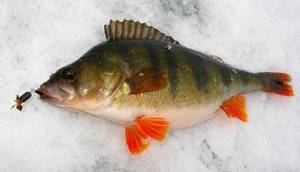
Ice feeder in the Baltics
In the Baltics, Normund Grabovskis is not the only one who uses a feeder in winter. Rodion, a well-known feeder blogger, also actively fishes with feeder tackle from the ice. The author constantly uploads new videos to YouTube, one of which is presented below.
Video about fishing in February. The weather was excellent that day and the fishing was expected to be good. Rodion uses a special short feeder from Salmo for winter. Equipment paternoster with feeder 30g. Leash with a diameter of 0.01mm, length 40cm. Nozzle bloodworms and maggots.
Fishing from ice in February with a feeder
Catching the devil video
Catching roach on the devil video
Large roach on Ukolov's little devil video. First ice.
Lessons on catching bream using a devil from a pro video
How to catch devils in winter video
In this video I talk about the winter fishing rod and show not only the structure of the fishing rod, but also some of its subtleties. In addition, I show with examples how to catch perch with a devil in winter fishing. You can fish with such a fishing rod both with a bloodworm and without a bloodworm jig. Thanks to the high-quality game of the devil, you can catch perch, chebak, bream and other fish in winter fishing. If you change the jig, you can easily catch live bait for pike fishing. But the most effective fishing for devils occurs precisely with perch, and you can catch very large perch with it even without a bite.
Suitable weather conditions
Active ice fishing for bream is often observed in stable weather, when there are no sudden changes in temperature, atmospheric pressure, and the wind blows in one direction. Underwater inhabitants feel normal at atmospheric pressure in the range of 735-745 mm.
The main thing here is that the weather be stable for at least two or three days. Promising fishing will be when heavy snow falls, and there are no strong gusts of wind, and it is cloudy throughout the day. In such conditions there is a chance to catch not only bream, but also roach.
Fishing rod equipment
Fishing for perch in winter with devils requires the angler to have the right and sensitive gear. You can use any fishing rod - store-bought fishing rods, balalaikas, fillies, light reelless fishing rods. More important is the setup of the gear. The devil, line diameter and nod are selected depending on the weight of the bait. The spread of the devils' weight distribution is large. It is advisable to pre-set several fishing rods for different baits.
The fishing line for catching perch in winter using devils is thin and strong, with a diameter of 0.1-0.12 mm. Thick fishing lines cannot be used for fishing - the action of the bait will be disrupted. If there is a high probability of catching large specimens, it is better to use 0.12 mm. This monofilament is both thin and strong enough for catching passive winter fish.
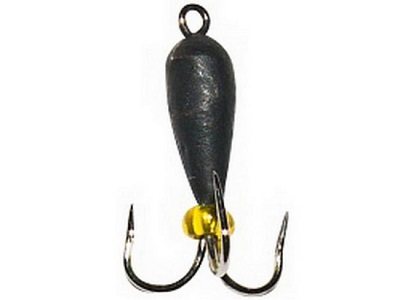
With eye
READ Features of catching grass carp in autumn – Rybalke.net
Video from Sergei Kurbatsky. December 2021
End of 2021. December 13, first ice - it's time to master the under-ice feeder. Sergey Kurbatsky went to the gum and was determined to catch roach and bream. Two holes and two winter fishing rods with a feeder on the paternoster. Winter bait from Fishdream, bloodworm on the hook. Leash Salmo Ice Power 0.14mm.
Catching bream and roach from ice with a feeder December 2018
The fish responded well to the bait. I take into account that we managed to get to the reservoir only at 10 am; several kilos of excellent roach and bream were caught.
How to assemble the tackle correctly
With one bait
Fishing rod
The fishing rod must meet the following requirements:
- be light;
- have a reel;
- be compact;
- fits comfortably in your hand;
- do not receive damage when throwing it onto the ice;
- resist snow accumulation.
balalaika fishing rod meets all these requirements . The reel provides the ability to quickly wind up the fishing line when moving from hole to hole.
Fishing rods with a reel (“reel”) are completely unsuitable for fishing with a fishing rod; a reel attached to a fishing rod is much less convenient than a built-in one.
fishing line
0.08-0.14 mm is used for devil fishing . With a thicker line, due to increased friction with the water, it is difficult to ensure the correct action of the bait.
Nod
The nod when fishing for devils is a very important detail. A nod up to 20 centimeters long , since only with the help of such a nod can the devil be given the necessary game. The nod should be elastic. Most often, lavsan nods are used, less often nods made from a clock spring.
The tackle is prepared as follows:
- wind the fishing line onto the reel spool;
- put a nod on the whip;
- pass the fishing line through the ring at the tip of the nod;
- tie up the devil.
With several baits
Locomotive
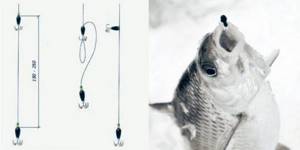
A steam locomotive is a tackle with two baits. It is also called tandem equipment. At a distance of 20-40 cm from the bottom line, another one is tied. This creates the opportunity to fish two layers of water.
Garland
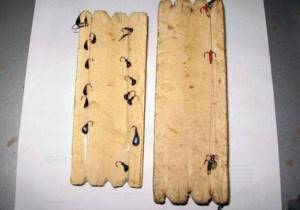
Catching pike on a balance beam in winter: where to look for the predator and how to catch it
The habits of pike, and therefore the characteristics of its fishing, largely depend on at what point in the freeze-up season you fish.
Predator migration during the closed water season
Pike migration is observed throughout the season and largely depends on how the young peaceful fish behave.
On the first ice, the catfish actively continues to feed and gain “fat” during the period of deep winter. Often at this time you can find pike in the same places where it stands in open water in late autumn. Near fallen vegetation, snags and other underwater objects that stand out against the background of a flat bottom plateau, as well as in holes and in areas near them.
At the same time, the pike follows the white fry, which spins at a depth of 1-3 meters near the coastal edge until it drops into the depths, where it continues to pick up the remains of food and enrich itself with oxygen. Such places are often marked by thickets of reeds, cattails, and shrubs.
When fishing for pike on a balancer on rivers (especially unfamiliar ones), you should look for the following points:
- coastal areas at river bends;
- noticeable changes in depth (checked by tapping the bottom using a cutter or other weight);
- noticeable differences in the speed of the current (an experienced fisherman can determine them by eye, or can easily be checked by the thickness of the ice - the thinner the ice, the stronger the current);
- any abnormal changes in depth (islands and depressions, edges, snags, stones, etc.);
- coastal and channel edges.
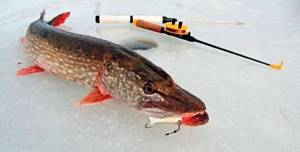
At the beginning of winter, especially when fishing on rivers, follow the rules of your own safety! Do not go out on the ice alone, always have a strong rope with you and check the strength of the ice with an ice pick before each step. Areas with strong currents, areas of hydroelectric power plants and industrial emissions are especially dangerous - this is where potholes in ice often occur.
In the middle of winter, in the so-called wilderness, it is quite difficult to provoke a pike to bite. It rolls down to deeper places and often stands there in a somnambulistic state.
The only places where it continues to be active are points saturated with oxygen:
- polynyas, both artificial and natural;
- areas where streams and small rivers flow into larger ones - where oxygen vortices are formed;
- places among reeds and cattails - oxygen enters through their hollow stems.
On the last ice, already in the spring, peaceful and predatory fish begin to become active and rush to the water’s edge towards the shore, where the first gullies are formed, which means the maximum concentration of oxygen is observed. Therefore, at this time, balancers that are suitable for shallow depths will be in favor (see review below).
You need to start studying the reservoir in the summer. It is easier and more promising than in winter. Fishermen who successfully fish on a reservoir in the summer in most cases have an advantage over those who go to a reservoir only on ice.
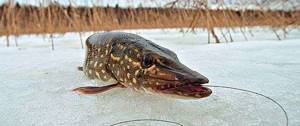
When fishing for pike it is important:
- constantly actively search for the predator until it is found out where it hunts at a given time of year/day
- change approaches to animating baits;
- change the baits themselves according to size, color, nature of the game;
- change fishing depths;
- walk through the holes several times - the pike moves and can return to a seemingly “empty” hole;
- monitor changes in weather conditions and respond appropriately to them.
The thaw is the time to go to the pond; it is in such weather conditions that the chances of success are higher than in severe frost.
Tactics and features of the balancer feed
Once on the reservoir, we select several promising areas for drilling holes (see above) and serially drill holes in a checkerboard pattern or otherwise, if the shape of the reservoir dictates this. Usually, for the first run, 8-15 holes at a distance of 8-12 meters from each other are enough. It is advisable to close the entire promising area at once.
For example, this could be the entire bend of the river, the entire zone of a coastal dump, or the area around a frozen snag.
Each hole is fished, starting from the first. The most interesting ones are selected and noted. If the entire area is silent for 30-60 minutes, then in general the predator is staying in a different place, or is passive and you need to try other balancers, or methods of presenting them.
On ice you need to not only be careful, but also be as quiet and unnoticeable as possible to the fish!
As for how exactly to work with a pike balancer, there are several basic techniques.
One of the main options:
- The balancer is lowered to the bottom and the depth is measured.
- The bait is undermined from the bottom by 15-25 centimeters.
- There follows a pause and the release of the fishing line, on which the balancer, shaking its sides, sits on the bottom.
- A pause is made for 1-2 seconds at the bottom.
- The cycle repeats.
It’s interesting to know how balancers and spinners behave under ice:
One of the variations, when the second step is not a detonation, but a smooth pull, is suitable for a more passive predator.
Another option is when, after detonating the bait 10-30 cm from the bottom, the fisherman begins to animate it at some distance from the bottom. This option is good if the bottom is muddy, or the predator does not feed from the very bottom.
Another possible method is when the balancer animates in the water column. It is used in cases when the fish rises closer to the surface - oxygen starvation, stands above a snag, etc.
The amplitude of the swing, as well as its sharpness, can change. From 5 to 50 cm - amplitude; and from very smooth pulls to extremely sharp jerks - the sharpness of the game.
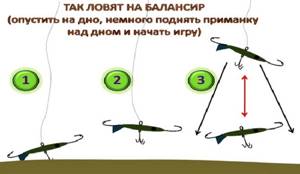
How to catch a predator on a balance beam:
Feeder in winter from ice on video
Vladimir Nikolaev could not bypass the recently popular under-ice feeder. For his first winter fishing with a feeder, he chose the Desnogorsk Reservoir. For fishing, a homemade rod is used: a feeder tip and a spinning rod handle. Small spinning reel size 1000.
Ice fishing took place in a tent; the temperature inside was always above zero.
Fishing in winter on the Desnogorsk reservoir
Good video from Pavel Balushkin. In it, the author talks in detail about the gear. Pavel decided to use the purchased sensitive rod with a reliable inertial reel for winter fishing for ice fishing. Such a reel with a drag simplifies the process of reeling in tackle and landing fish as much as possible.
Fishing in winter with a feeder on video
According to the author, the use of feeder equipment and a feeder, casting the gear once every 15 minutes (or so) is suitable for those people who do not set a goal to catch as many fish as possible, but for those who value the search for new methods and sensations in fishing. The use of bait and the feeder method of feeding it may seem unnecessary to many anglers accustomed to the “classics” of winter fishing.
